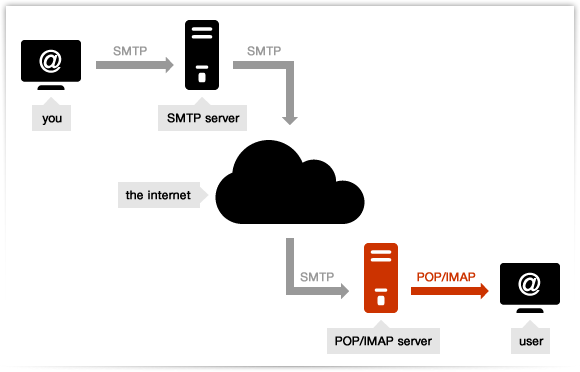IMAP, SMTP, and POP3 are the most widely used email systems on the Internet. Each of them serves a different purpose and method. Both IMAP and POP3 read emails from the remote server. While SMTP is for sending emails. In comparison, IMAP is much better than POP3.

IMAP
Known as Internet Message Access Protocol. IMAP is used to receive emails from a server. IMAP settings have the option of storing emails on the mail server. It provides an edge for the user to access emails from multiple locations, and it also allows simultaneous access by multiple clients. This is why IMAP is more apt if the user accesses his/her email from different locations or if the messages of the user are handled by multiple people.
The end-user can delete or allow the post as it is in their inbox after going through emails. Offline mode is also supported for this setup, which means that even when offline changes are visible after reconnection. To understand it accurately, a copy of recent emails and old emails will be available online.
Ports on which IMAP protocol works:
- Port 143:- This is the default port for IMAP and it is non-encrypted.
- Port 993:- This port of IMAP is used for establishing a secure connection.
POP3
Represents Post Office Protocol version 3. It is used to download emails from the remote server to the local client. POP allows us to download email messages from a local computer and delete emails from the server. This leads to less space usage on the server. Although it supports offline email processing, it lacks advanced features like contacts, etc. It only downloads new emails which have been received.
Ports on which POP3 protocol works:
- Port 110:- This is the default port for POP3 and it is non-encrypted.
- Port 995:- This port of POP3 is used for establishing a secure connection.
SMTP
SMTP is an abbreviation for Simple Mail Transfer Protocol. The main work of SMTP is to send emails. It can be used by the client to send emails to the server or used by one server to send emails to another server. Precisely, in an SMTP scenario, the server decides the operations it wants to execute/operate. The other server authorizes the operation and this is how the message is sent.
Ports on which SMTP protocol works:
- Port 25:- This is the default port for SMTP and it is non-encrypted.
- Port 2525:- In case, port 25 is filtered and the user sends non-encrypted emails.
- Port 465:- This port of SMTP is used for establishing a secure connection
IMAP vs POP3 vs SMTP
| Basis | IMAP | POP3 | SMTP |
Full-Form |
Internet Message Access Protocol. |
Post Office Protocol. |
Simple Mail Transfer Protocol. |
What is its definition? |
IMAP Internet Message Access Protocol is used to retrieve emails from the server. |
POP Post Office Protocol is also used to retrieve the emails from a remote server to a local computer. |
SMTP Simple Mail Transfer Protocol is the standard protocol for sending the emails over internet. |
Major Functionality |
Receiving emails. |
Receiving emails. |
Sending emails. |
|
Ports |
IMAP typically works on 143 ports. |
POP3 typically works on ports 110. |
SMTP typically works on 25 ports. |
|
What are the drawbacks? |
The inbox on the server has limited space, therefore the user needs to ensure to empty some space for newer emails. | It cannot be accessible from multiple locations. Once, the email gets downloaded on a local computer it is accessible only there. | IN SMTP setup, the sender cannot be verified. This, in turn, leads to SPAM issues. |
Layman’s Terminology |
Incoming. |
Incoming. |
Outgoing. |
Conclusion
In conclusion, three major protocols are used in email. IMAP and POP3 are the incoming emailing protocols that retrieve emails from the server to the local client. On the other hand, SMTP is the outgoing emailing protocol that sends out the emails from the client to the server or from one server to another.
The post IMAP vs POP3 vs SMTP – Know the Difference appeared first on The Crazy Programmer.
from The Crazy Programmer https://ift.tt/3DKUEQF
Comments
Post a Comment